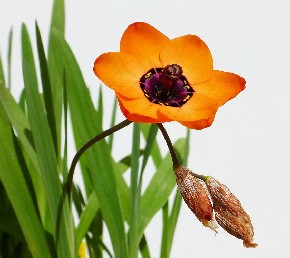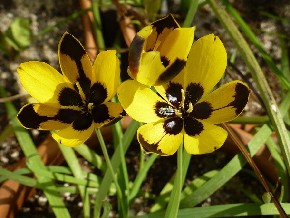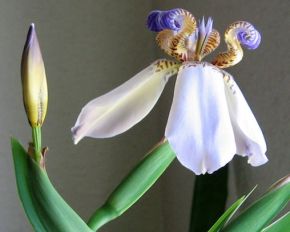|
First, let's talk about Irids.
The Family Iris contains about 80 genera, one of which is the Genus Iris. The other genera are collectively refered to as Irids -- which means "Iris-like plants". With only a few exceptions they are geographically restricted rather than widespread across the globe like Iris. These genera are sometimes small and subject to reclassification, occasionally being absorbed into larger genera. The list below includes those larger more stable genera.

- Alophia - North America
- Aristea - southern Africa & Madagascar
- Babiana - southern Africa
- Bobartia - South Africa, endemic
- Calydorea - southern North America (Mexico, Florida) & South America
- Chasmanthe - South Africa, endemic
- Cipura - Central America, West Indies, South America
- Cobana - Honduras & Guatemala
- Crocosmia - eastern and southern Africa & Madagascar
- Crocus - Mediterranean region, central Europe to central Asia
- Cyanixia - Indian Ocean island of Socotra, endemic
- Cypella - South America
- Devia - South Africa, endemic

- Dierama - southern Africa
- Dietes - central and southern Africa & Lord Howe Island in Australia
- Diplarrena - Australia, endemic
- Duthiastrum - South Africa, endemic
- Eleutherine - Central America, West Indies, South America
- Ennealophus - South America
- Ferraria - central and southern Africa
- Freesia - eastern and southern Africa
- Geissorhiza - South Africa, endemic
- Gelasine - South America
- Geosiris - Madagascar & Mayotte Island

- Gladiolus - South Africa, tropical Africa, Mediterranean, Europe, southwestern Asia
- Herbertia - southern United States, South America
- Hesperantha - central and southern Africa
- Hesperoxiphion - northwestern South America
- Iridodictyum - Europe to cental Asia (usually included as Genus Iris)
- Isophysis - Tasmania, endemic
- Ixia - South Africa, endemic
- Juno - Mediterranean to cental Asia (usually included as Genus Iris)
- Klattia - South Africa, endemic
- Lapeirousia - central and southern Africa
- Larentia - Mexico, South America

- Libertia - South America, New Zealand, Australia, New Guinea
- Mastigostyla - South America
- Melasphaerula - Namibia, South Africa
- Micranthus - South Africa, endemic
- Moraea - Africa, Mediterranean, southwestern & central Asia
- Nemastylis - Central America to southern United States
- Neomarica - Mexico, Central America, South America, Trinidad & Tobago
- Nivenia - South Africa, endemic
- Olsynium - South America and western North America
- Orthrosanthus - Australia, South America, Central America, Mexico
- Patersonia - Australia, Indonesia, New Guinea, New Caledonia
- Phalocallis - southern Brazil, northeastern Argentina
- Pillansia - South Africa, endemic
- Pseudotrimezia - Brazil, endemic

- Radinosiphon - southeastern Africa
- Romulea - Africa, Mediterranean, Europe, Middle East
- Savannosiphon - tropical Africa
- Sisyrinchium - North America, South America, West Indies, Hawaii, Greenland, Bermuda
- Solenomelus - Argentina, Chile
- Sparaxis - South Africa, endemic
- Syringodea - South Africa, endemic
- Tapeinia - Chile, endemic
- Thereianthus - South Africa, endemic
- Tigridia - Mexico to Chile
- Trimezia - South America to Mexico, Florida, West Indies
- Tritonia - southern Africa
- Tritoniopsis - South Africa, endemic
- Watsonia - southern Africa
- Witsenia - South Africa, endemic
- Xenoscapa - southern Africa
- Zygotritonia - western Africa to eastern Africa, and island of Socotro
The Pacific Bulb Society maintains a fantastic collection of photos from gardeners experienced with growing these beauties. SIGNA's own Species Database has lots of irid species too.
[Continue reading about different types of Irids...]
|
 Species Iris Group of North America
Species Iris Group of North America